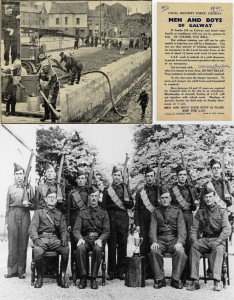Galway's Wartime Experience

GALWAY’S WARTIME EXPERIENCE
“At 11.15am on the morning of the 3rd of September, 1939, we heard Mr. Chamberlain’s momentous speech declaring war on Germany. Each succeeding hour, the radio announced news. The first major item to be broadcast was that the
liner SS Athenia had been torpedoed 250 miles off the Outer Hebridies. To us sitting at our firesides in Galway, this seemed remote. Business continued as usual, although groups of people discussed the war, and the Athenia was temporarily forgotten. Sometime around midday on Monday, a wireless message was picked up by the Galway Harbour Commissioners tender “Cathair na Gaillimhe” which was lying in the dock, from a Norwegian freighter, the MV Knute Nelson saying that she had picked up survivors from the Athenia, and that she was making for Galway. The news spread rapidly among the 17,000 inhabitants of the town”. This was how Frank McCabe described Galway’s entry into the war, a mere few hours after it had started. A meeting of the heads of all emergency services, and civic and religious leaders was immediately called, and a plan of action drawn up. Hospitals, nursing homes, guest houses, hotels and institutions were visited to find out what accommodation was suitable. Plans were made for every available ambulance, bus and car to stand by to escort survivors to temporary homes and hospitals. The tender sailed out to meet the Knute Nelson and medical teams went aboard immediately to treat the wounded. They were rushed to hospital accompanied by nurses and orderlies, while others were taken to hotels and institutions. All were given ‘the freedom of the city’ as far as cinemas, dances and busses were concerned.. It was several weeks before the last of them left Galway.
Galway was soon among the list of ports banned to American shipping. The Harbour Commissioners cabled a number of prominent people of Irish descent in the US advising them that £25,000 had been spent on improvements to the port, and that it should be given the benefit of neutrality, and maybe they could use their influence to have the ban reversed. In June, 1940, the US liner “President Roosevelt” sailed into the bay to collect 720 Americans from various parts of Ireland and the UK, to bring them home. The following November, a Japanese liner the “Husimi Maru”, arrived to pick up 185 Japanese subjects who had left Britain, to bring them home.
Because merchant ships were regarded as targets, the island of Ireland was virtually cut off during the war. Many products that would normally have been freely available became scarce. Rationing was introduced and basic foodstuffs were sold in small amounts.... tea was reduced to a half ounce per person per week. Every house had its own ration book. Petrol was difficult to get unless you were in the emergency services, drove public transport or were a doctor. Many people simply parked their car until the war was over.
In the first years of the war, the numbers in the Army multiplied by between six and seven times. They began by calling up on permanent service part-time soldiers already in existence, ie. Reserve and Volunteer Units. By early summer, 1940, numbers had to double again. These new recruits had to be trained, and this put a major strain on Army resources.
Parallel with the army expansion came the launching of the Local defence Force (LDF) and the Local Security Force (LSF). The LDF was composed of men qualified for military service who were willing to assist the defence forces in the field. They were armed with shotguns, sporting rifles and other such weapons. The LSF was designed to be an auxiliary police force. Both of these groups were trained by the Gárdaí, but the Army took control of the LDF in January 1941. Members of the LSF were trained in squad drill, first aid, air raid precautions (ARP), weapon training, protection duty, duty at fires, beat & patrol duty, aerial observation, traffic control, police duties, etc, and in measures to be required in emergencies such as fire-fighting, rescue & demolition work. Their uniform was blue and similar in pattern to the brown LDF one.
The ARP services provided for Galway were; The Casualty Service, The Auxiliary Fire-fighting service, the Rescue Service & the De-contamination Service, all under the control of the County manager. An air raid warning was given to the public by sirens and the Gárdaí and LSF would take up the warning by blowing whistles. If sirens gave a sustained note, it meant that the danger had passed. The presence of gas in the area was indicated by hand rattles operated by the ARP men. The ‘gas clear’ signal was given by hand bells.
Other highly trained groups in a state of readiness were The Red Cross & the Order of Malta. A women’s committee was set up and they knitted balaclavas, socks and bags for the LDF. They used to scour & clean old Castrol bottles and convert them into water bottles, and they helped by making tea & sandwiches when the boys were on manoeuvres.The public were advised to protect themselves and their property against incendiary bombs by having available buckets of sand & water and a stirrup pump, thus enabling them to deal with a local fire.
Our main photograph is a collage showing an ARP man with a rattle indicating the presence of mustard gas; bottom left is a decontamination squad dealing with a mustard gas attack; LSF men being trained in fire-fighting at Spanish Parade. Our next image shows an LDF group. They are, in front, Prof. Murphy, Dr. De Courcey, Mr. McDonagh & Harry Flattery. Back Row; Cyril Mahony, P O’Sullivan, Tim Tierney, P. Rabbitte, T. Lynskey, M. Geraghty and J. Braines. Image no. 3 is a notice from the LSF dated 1942.
